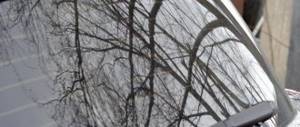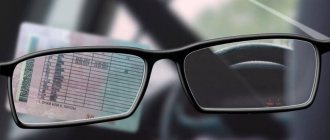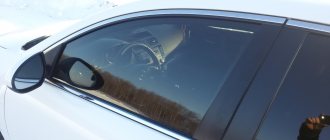Types of tints
Tint films are divided into several categories:
- painted. They are inexpensive and are made by painting a polymer base. They do not create glare and reflect up to 50% of the sun's rays. Quite resistant to external influences;
- metallized. Such films, in addition to the applied layer of paint, have an aluminum coating, which makes them look mirror-like. Due to the presence of glare, models with a capacity of 10, 15 or even 80 percent are currently prohibited under Russian law;
- Spatter, Infinity. They are a type of metallized products with low throughput (about 15%), which also makes their use illegal on the territory of the Russian Federation;
- with transition. Thanks to the increase in color density, they have maximum protection from sunlight. They protect well from the heat when the sun is at its zenith. Today, car enthusiasts cannot use models with 35 or 50% protection, as well as products with 10 or 15% protection;
- athermal. Appeared on the market relatively recently. There is no glare on them, both conventional (35, 50% light transmittance) and more transparent models perfectly protect the driver’s eyes and prevent sunlight from penetrating into the cabin.
Types of tinting: visibility in percentage
Depending on the flow of light that the devices transmit, they are distinguished:
- films with 5, 10 or 15 light transmission. Through 10-15% of the film from the outside it is practically impossible to see what is happening in the car, however, visibility for the driver is significantly deteriorated;
- films with 20-35% light transmission. In products that transmit 35% of the sun's rays, you can see the silhouettes of people in the car, so before the ban, films that transmit 35% of the sun's rays were most often purchased by drivers;
- films with 40-70% light transmission. Through devices that transmit at least 50% of light, you can see some objects in the car, but now 50% of the film is not allowed by law;
- films with 75-95% transmission of sunlight. They practically do not darken the car, but only they can be installed on vehicle windows so as not to pay a fine.
What is tinting “35”
This number indicates the percentage of light that passes through the material. In this case - 35%, this is exactly how many rays the film will transmit.
Here you need to pay attention to the rules. According to the regulations of the Customs Union, as well as GOSTs, such a film cannot be used on the windshield, as well as on the rear, if there are no side mirrors. The traffic rules indicate that such a violation will result in a fine.
Important!
There is no prohibition on continuing movement. The inspector can only issue a fine, nothing more. He cannot send the car to the impound lot. Although there is always a risk that you will be “accepted” by the next crew you meet and you won’t get off with just a fine.
It is worth considering that it is prohibited to use mirror and color films. You will also receive a fine for such tinting.
Tinting is usually 0.5 mm thick. On the one hand, this does not increase the thickness of the glass, which is especially important for doors. On the other hand, the thickness provides sufficient strength.
The degree of transparency depends on the density of the coloring pigment. Almost all films have two or three layers. Two-layer options.
- Painted. In this case, the darkening effect is achieved by applying paint to the material. Cheap and short-lived option.
- With polymer coating. A special polymer is applied to the film. Due to high adhesion and resistance to ultraviolet radiation, this tint lasts for a long time without fading.
- Carbon. Graphite filling is applied to the film. It has a matte surface and high cost.
There are also three-layer films. The most common ones are metallized. A coating of metal particles is placed between the layers of polymer. You should not use aluminum options, they have a prohibited mirror effect.
A film with a light transmittance of 35% protects the interior well from ultraviolet radiation. Tests show that the material transmits no more than 1% of ultraviolet rays.
What does a car look like with 50 transparency tint?
Mazda tribute
But how to choose a tint, what should you consider when choosing it?
Due to the direct rays of the sun, the temperature on interior surfaces with darker colors may approach 80°C. Thanks to tinting, a noticeably smaller amount of solar radiation will pass through the window openings.
Let's figure it out. As a result, traffic police inspectors do not object to it; this is the only option for film tinting that is certainly allowed. At the same time, when using it, passers-by can easily see what is happening inside the car. Metallized or mirror film Products of this type not only protect against excess solar radiation, but also protect the interior from prying eyes.
At the same time, it is not worth applying such a coating to the windshield or front side windows, since they are certainly prohibited for these windows.
Metallized film Infinity has gained considerable popularity among consumers, which provides high visibility from the inside with minimal visibility from the outside. Colored film This is a coating that has been given a specific color, in particular, green, blue, brown or another. Therefore, their darkening must comply with current regulations.
What percentage of tint is allowed?
Content
What percentage of tint is allowed?
Tinting percentages, light transmittance standards
Types of tints by percentage
Types of tint films
The most affordable type of car styling today, which allows you to radically change its appearance, is window tinting. Many car owners strive to use this procedure not only to change the exterior of the car and increase the comfort of staying in its interior, but also to create a private, isolated space in it, to ensure the privacy of themselves and their passengers. But window tinting also reduces visibility for the driver, especially at night. Therefore, their darkening must comply with current regulations.
Tinting according to GOST
Tinting percentages, light transmittance standards
Tinting, preventing the penetration of sunlight into the interior, protects it from overheating in the summer heat and from fading of the interior decoration under the influence of ultraviolet radiation. This creates a favorable microclimate inside the car, helps save air conditioning resources and reduces fuel consumption. But, before tinting your windows, you need to know well what percentage of tinting is allowed in order to avoid unpleasant meetings with traffic police officers that end in a fine.
For a long time, GOST 5727-88 was in force in Russia, allowing glass tinting only in the factory version, and limiting the light transmission of the windshield to 75%, and the front side windows to at least 70%. Starting in 2015, a new regulatory document, GOST 32565-2013, came into force, providing for many changes in the area of car window tinting. The main ones:
- reduction of the lower threshold of light transmittance for the windshield from 75 to 70%;
- establishing a fixed maximum permissible width (140 mm) of the sun protection strip in the upper part of the windshield, the light transmission parameter of which is not standardized;
- recognition of the possibility of darkening windows using tinting films, which at the official level for the first time legalized tinting (the new GOST contains the formulation of safety glass for a wheeled vehicle with a polymer coating);
- formulation of the concept of energy-saving glass made using athermal technology or coated with athermal film;
- removal of the ban on the use of mirror glass, although this issue was never fully resolved by other regulatory documents.
Recommended width of sun protection frontal strip
According to the new GOST, all auto glass is divided into two groups:
- glass providing the driver with forward visibility (first category);
- auto glass serving for rear visibility (second category).
The permitted percentage of car window tinting is set at the following light transmittance levels:
- windshield – 70%;
- front side – 70%;
- tinting of rear hemisphere windows is not standardized if there are external side mirrors (if they are absent - 70%).
Taking into account the requirements set forth in the new GOST and the appearance of athermal film coatings on the market, it has become possible to legally create comfortable conditions in the cabin by applying tinting even to first category glass.
Types of tints by percentage
Today, it is quite legal to tint a car if all the requirements of GOST 32565-2013 are met, that is, the light transmittance of the “glass plus film” structure for the windows of the front hemisphere is not lower than 70%, and for the rest - at the discretion of the driver, provided, of course, there are side ones exterior mirrors providing an overview of the road situation behind the vehicle. For glasses of the second category, the following types of tinting can be used:
- 5 percent tinting, obtained by applying the darkest tinting films, and providing maximum privacy for the interior, it creates the most effective barrier to the penetration of sunlight and ultraviolet radiation, but visibility through such glass, especially in the dark, will be quite uncomfortable;
Tinting 5 percent
- A 10% tint allows only 10% of the light to pass through, and is used primarily for privacy, as lighter athermal films would provide similar UV and sunlight protection;
- tinting of 15 percent creates the effect of one-way visibility, when it is quite difficult to see the interior from the outside, but everything is visible from the inside very well; if GOST is observed, a sharp contrast will be noticeable between the windows of the rear and front hemisphere;
- 20–35% tinting already allows you to see the silhouettes of people in the car from the outside, providing fairly good visibility from the inside; films with such light transmission are the most popular among lovers of isolated comfort, although they are not able to provide complete insulation, since they cannot be used for glass first categories;
- tinting of 50 percent or more looks like slightly darkened glass, meanwhile creating a completely comfortable atmosphere in the cabin both in terms of visibility and protection from the sun. With such tinting of the rear hemisphere glass, they will be more organically combined with even the lightest athermal films on front windows.
When choosing a light tint, it is better to use athermal films, which provide good protection for the interior from overheating and cooling, while making the outside of the car stylish and modern.
Thanks to the special structure of such films and a slight greenish or purple tint with tints, the car interior does not look completely transparent.
Tinting of 50 percent or more looks like slightly darkened glass
Types of tint films
The modern market can offer a large selection of film coatings of various types for tinting car windows. Among them:
- painted vinyl films, in which the darkening is created by introducing paint into the polymer mass, they are characterized by the lowest cost and short service life, due to the fact that the paint fades over time from sunlight;
- metallized films, which have a layer coated with metal, most often aluminum, which increases their durability and provides better protection from thermal energy;
- spatter film coatings in which the metallized layer is deposited using the ion exchange method;
- Infinity brand films, which have aluminum coating not in the inner, but in the outer layer, such films retain up to 70% of thermal energy and have a low light transmittance of up to 15%;
- gradient film coatings or films with a transition, which are a combination of metallized and painted tints, as a result of which a transition from a darker color to a lighter one appears, from top to bottom;
- athermal films, including those with the “Chameleon” effect, which, with high light transmittance (up to 93%), retain up to 80% of solar energy, completely block infrared and ultraviolet rays, and significantly reduce glass glare (up to 40%).
Athermal tint film
To tint car windows, it is best to use films from leading global manufacturers such as well-known brands such as Llumar and Sun Control, Suntek HP, ASWF or Johnson, which are of high quality and provide ideal transparency, without any distortion. In addition, the actual light transmittance of branded tints always corresponds to the passport value, which is very important when selecting the required tint density if you want to achieve its compliance with GOST requirements.
Light transmittance standards
UAZ on tracks
The standard is:
- for the windshield - no less than 75%;
- for side windows - no less than 70%;
- for rear windows - a different value, but subject to the presence of rear-view mirrors on the right and left.
However, it is not allowed to tint the car with mirror films. A film that allows varying amounts of light to pass through can be applied to the windshield, but its width should not exceed 14 centimeters.
Mirror tinting is not prohibited for rear windows
To determine what percentage of a car's light transmits, certain weather conditions are needed. The analysis is carried out at air temperatures from -10 to +35 degrees, humidity no more than 80% and glass thickness no more than 2 cm.
To calculate the rate of sunlight transmission, it is worth carrying out simple calculations. Let's say the panels' ability to transmit sunlight is 95% (factory glass does not have 100% solar transmittance by default), and you are going to buy a tinting film with a corresponding indicator of 50%. It is not difficult to calculate whether you fit into the standard: 0.95 * 0.5 = 0.475, that is, 47.5%. It is this value (and not the degree of permitted film throughput) that will be taken to determine the legality of tinting. Based on the law, 47.5% is a violation of the norm, for which penalties are provided.
Penalties for violation are as follows:
- 1500 rubles - for the first violation;
- 5,000 rubles for the second violation. If a driver violates the same law again within 365 days of the last violation, he will either be fined a tidy sum or have his license suspended for 1 to 3 months by a court decision.
Traffic police officers will be able to estimate what percentage of rays the film transmits not only at specially equipped points, but also at any other posts. The degree of compliance of tinting with the standard is assessed using a taumeter. Employees of the authorities must have the appropriate documentation for it (certification, documents with the date of the last reconciliation), as well as seals. It turns out that in order not to violate Russian legislation under Article 12.5 of the Code of Administrative Offenses of the Russian Federation, you will have to either not tint the panels at all, or take a film with the permitted capacity (definitely not 10 or 15, but approximately 80 percent), which will also not make life much easier for the driver.
Taumeter is a device that helps determine the percentage of glass darkening
conclusions
Tinting with a transparency of 30% is allowed for use, but with some restrictions. In particular, you cannot use such a film on a windshield. In other cases, the inspector will not have any questions.
When choosing a film for car tinting, decide which type is best for you. Choose a manufacturer. Cost is not a determining factor, the only exception is a tint film that is too cheap, it can bring you unpleasant surprises.
If you can’t make a choice yourself, ask a familiar car mechanic or a consultant in a store to help.
Car window tinting percentage
Pajero mini
Why you need car window tinting is no longer necessary to explain to anyone
A suitable choice of shading is what is important for those who want both the driver and passengers to feel cozy and comfortable
Car tint color
The most comfortable color for the eye is a neutral charcoal-gray filter color. With this filter color, the natural color rendition is completely preserved, and the eye almost does not notice such tinting. There is no additional nervous tension or fatigue
This is important for both health and road safety. It is because of this that car tinting with color films is becoming less and less common today.
Shade level
The degree of darkness is determined by a number indicating the percentage of light transmission of the film. Film marked “5” allows only 5% of light to pass through, and therefore provides maximum darkness. Film marked “35” transmits 35% of light, i.e. it is much lighter than the “five”.
Tint films have standard light transmittance values: 5, 10, 15, 20, 35 and 50 percent. The most popular films are those with 5, 15, 20 and 35 percent light transmission.
Tinted cars are usually made according to the following scheme: rear - 5%, front door windows - 15%, windshield - 35%. From the outside, the interior of such a car is not visible at all. True, it’s quite dark inside, to put it bluntly. Especially at dusk and in rainy weather, driving such a car is not very comfortable. If you also tint the front windows with “five”, then when parking in a dark yard you will have to lower the front windows.
A more common and more universal option for tinting a car is when all windows, except the windshield, are tinted with a film with a light transmittance of 15%. With such tinting, the rear passengers are practically invisible; the silhouettes of those sitting in front are visible. Although, a lot depends on the lighting and the viewing angle.
The effect of darkness on visibility can be described something like this:
| Light transmission | Outside | From the inside during daylight hours | From inside in the dark |
| 5% | nothing is visible | satisfactory visibility | bad visibility |
| 15% | silhouettes are visible | satisfactory visibility | bad visibility |
| 20% | faces are visible | very good visibility | good visibility |
| 35% | everything is visible in detail | excellent visibility | very good visibility |
When tinting a car in accordance with GOST, i.e. Without darkening the front door windows, the front part of the cabin is completely visible. At the same time, of course, visibility from the car interior is also excellent. The backrests of the front seats prevent light from entering the rear of the cabin. Therefore, even with completely transparent front windows, tinted rear windows protect passengers and things in the back seat from prying eyes.
When only the rear windows are tinted, the correct choice of film plays an important role in the harmonious and attractive appearance of the car.
Which tint to choose for your car is entirely a matter of your taste and preference. We hope that it will now be easier for you to navigate and make the right decision. Our experts and consultants will be happy to answer any questions you still have and, of course, will do everything wonderfully.
So, how are we going to tint?
Headlight reservation
To main
Tint color
One of the main parameters of tinting is its color. As a rule, it is chosen depending on your preferences and compatibility with the color of the car body. Let's consider what tinting colors exist and how they affect a person.
| Color | Impact on humans |
| red | increases heart rate, blood pressure, and excitability |
| pink | induces a state of mild euphoria |
| yellow | increases concentration, has a positive effect on the psyche |
| green, blue, blue | calms the nerves, has an anti-stress effect |
| grey | neutral, does not distract a person from the world around him |
It is known that color is perceived by eye receptors, which initiate a chemical reaction, resulting in the production of electrical impulses that stimulate the nervous system. Then the impulses are transmitted to the brain, which, in turn, gives a command to produce certain hormones. Hormonal levels are the basis of human emotions. In such a complex way, color affects a person’s psycho-emotional state.
The most undesirable color for tinting car windows is red and its shades, because it is this palette that provokes agitation and aggression in a person. And this is an undesirable factor for the driver; when driving a car on city streets, even without this there are many reasons to increase the level of excitement.
The most neutral color for perception is considered to be charcoal gray. It does not distort a person’s perception of other colors and does not itself contribute to the production of adrenaline, i.e., it does not provoke nervous excitement and fatigue.
Kinds
If we consider the varieties of methods, first of all you should decide what exactly you plan to darken: the entire surface or a strip in the upper part.
If 10 - 15 years ago in Russia the only method of darkening was used, using films, now the tinting process can be performed from different angles. Traditional application of a film that is separated according to its physical and structural characteristics.
The most common options are:
- Athermal is a chameleon film that has minimal darkening, but has a pronounced color tint.
- Traditional carbon film.
- Mirror – metallized coating with reflective properties.
- Standard, factory - used at the glass production stage, by adding darkening additives to its composition or by plasma spraying occurring in a vacuum chamber. This condition is applied to almost all modern cars; the light transmittance in this case does not exceed 65%, which fully complies with the requirements of GOST 32565-2013 “Safety glass for land transport”.
In addition to traditional film coatings, to achieve results you can use electro-tinting, created on the basis of modern innovative developments:
- “PDLC” (Polymer dispersed liquid crystal) technology involves the production and application of a special film that has the ability to change the light transmittance at the request of the car owner.
- “SPD” (Suspended Particle Devices) technology provides for a more complex design when the glass is processed at the production stage. As a result, it acquires the ability to change transparency at the command of the car owner.
Adjustment of the last 2 methods is carried out by pressing a separate button installed on the dashboard or via the remote control.
Other existing tinting methods, such as double glazing, rigid removable silicone, curtains and others, are not taken into account, since they are not used for windshields.
Permissible darkening of car windows
Over the past couple of decades, the law on tinting has undergone several changes. According to the new GOST 32565-2013, some relaxations were made. Now the lower limit of tint is 30%. This light transmission value is acceptable for the windshield and door windows of the front hemisphere.
Windshields can also be shaded using a 14 cm wide dark strip, which should not interfere with visibility. 30 percent tint looks like a light coverage.
Glass itself has a light transmittance of about 80%. Therefore, it is now possible to glue athermal films to windshields, which in total will provide a tint of 30%.
Any tint is acceptable for the rear window and rear door windows.
The nuances of choosing what to cover the rear and front windows of a car
Having decided on your attitude to GOST and its standards, you can proceed directly to choosing an option for yourself. Please note that the glass itself does not transmit 100% of the light (usually 90-95%). Before installation, it is advisable to take a small piece of material and check the total light penetration rate with the device.
Let's start with the "state employees". If finances are very limited, then you can even look towards Chinese film. Just don’t glue it yourself - you’ll suffer, use the services of pasters (you can then demand that the defects be eliminated from them). If you are consciously prepared for a short service life and gradual loss of color, this may be your option.
Dyed films from “famous” manufacturers from the previous section are distinguished by better strength and ease of gluing than Chinese ones. You can choose a more expensive film and edit it yourself. For the same money you will get a better quality car product.
The next “level” includes all types of metallized films: color, gradient or simply black. In addition to changing the appearance, the “load” includes protection from ultraviolet rays and good wear resistance (you can count on 5–6 years). True, you will have to pay extra for these properties. Good craftsmen can apply almost any design to color film (at the same level as airbrushing). If you are willing to pay an extra +30% for a higher quality product, take a tint film made using spatter technology.
Don't forget that the rear windows of a car are still intended for something. Or at least get a panoramic rearview mirror
Athermal film is suitable for practitioners who decide to comply with the law. Transparency allows you to completely cover the windshield and front windows. A high-quality “athermal” retains up to 90% of heat from the sun’s rays. Many people note that after installation they began to turn on the air conditioning much less often. This is achieved through multi-layering (up to 20 layers, depending on the manufacturer). Each layer blocks a specific narrow spectrum of ultraviolet and infrared rays. Naturally, such complex technology leads to higher costs. This is an option for those who are willing to pay for their comfort (windshield from 3,000 rubles). “Chameleon” performs the same functions, only with a beautiful shimmer, so it costs twice as much.
Color and gradient films are suitable for tuning lovers. Usually in such cases the "invisible" properties do not have much meaning. The main thing is to choose the right color.
When choosing a film for tinting, the main criterion is price. If there is no certain amount, then the choice is limited. But for every thousand you put on top, you get additional properties. Decide how important they are to you, and the choice will become clear. If you don’t glue it yourself, then take an interest in the finished work or find reviews on the Internet about how they can ruin the best film.
Materials
Once you've decided that your car doesn't look good without tint, it makes sense to decide what kind of film to buy. Now there are a lot of different films on sale, they all differ in service life and technical characteristics, and can also look different on the car.
- Painted. Cheap and short-lived material. Tinting is achieved by applying dye to the polymer film.
- Metallized film and spatters. They have a metal coating. The difference is in the way it is placed. A simple metallized film has a coating placed between two polymer layers. Spatters are made by depositing particles directly onto the polymer under certain conditions. Do not buy aluminum-based tinting, it has a mirror effect.
- Athermal film. Perfectly protects the interior from scorching sun rays. Special polymer additives prevent the air in the cabin from overheating. Even in severe heat, the car will be quite comfortable.
- Gradient film. Has a transition that differs in color or density. Allows you to get an original appearance.
- Carbon tinting. This type is more expensive, but also lasts longer. A thin layer of graphite is applied to the polymer base. The result is a beautiful, matte darkening.
- Removable toning. Can be quickly removed or put back. Typically used as a temporary solution.
Tinting 50 in Moscow
At night, such tinting will create unfavorable driving conditions, as it will limit the view of road traffic due to excessive darkness, which can lead to accidents and other critical situations on the road. Class Cost (RUB) Middle class 2500 4000 Jeeps 3300 4000 Two front 1600 2100 + front 1000 1500 windshield from 2300 from 3500 Lifetime warranty on tinting! Our workshop carries out any type of tinting, including 50% tinting.
We guarantee reliable, high-quality, durable tinting of your car, since for this we have three main components: a comfortable workplace, the best tinting films from leading manufacturers and experienced professional craftsmen. We tint any make of car in the shortest possible time at affordable prices.
More information about our service To sign up for the service, call Opening hours 10.00 - 21.00 Or
DenisKalistratov Blog FAQ Choosing tinting.
Part 1 Black toner96
In the photo there is a good option with a blue car. If you wish, you can stick 35 or 50% on the top of the DSLR so that it does not mirror in the cabin. The price is from 1500 to 5000 rubles for the rear hemisphere BB on the right, the glass is tinted in bulk, and on top there is a blue DSLR2. If we have an aquarium, then you can glue whatever you like, but 7 out of 10 cars stop on a black carbon film with a light transmittance of 5%, as a result we will have an interior (storage room) that is not visible from the rear, you can leave a bag or other things in the back seat without worrying that someone will take them away and steal them. Price from 1500 to 2500 rubles for the rear hemisphere 1 out of 10 cars are those whose owners do not worry about hiding something in the cabin, but are tinted mainly for protection from the sun, so that the interior would not be so hot, it would be clearly visible when driving backwards.
It's bad from the street during the day, but you can see the interior, you can see the outline of a sitting person.
Film is chosen by 15-20% Price from 1500 to 2500 rubles for the rear hemisphere Around 20%, not a very good photo.
How to trim
Cutting edges protruding beyond the glass area is preferably done in 2 stages:
- It is recommended to start with a piece of paper on which the boundaries of the surface to be processed are marked.
- Using the finished stencil, the required area is cut out from the tinting material spread out. This can be done with ordinary household scissors.
- It is desirable that the film blank protrudes beyond the window by 3–4 mm; if necessary, this will allow the film to be moved in the desired direction.
- The second stage of cutting the film is carried out after it is transferred to the glass and partially smoothed.
In this case, you will need a good stationery knife, which will cut off the excess that protrudes beyond the surface and overlaps the sealing gum.
Which tint will be better for a car in 2019
Another affordable option is to purchase ready-made tinted glass. According to the law, the windshield and front side windows should not be tinted in principle, since these windows must have 70 percent light transmittance and tinting will not make it possible to achieve this indicator. Tinting is a method of finishing car windows, which consists of reducing their light transmittance.
It can be done in a number of ways, the most common of which is the use of film. Tinting has a number of functions that make this type of finishing so popular.
In particular: Thanks to tinting, it is possible to avoid overheating of the car interior and the people in it in the summer. In addition to visible color, such finishing will also delay ultraviolet rays.
What is the difference between tinting material?
The athermal effect is an important advantage, since the film prevents excessive heating of the interior. Thus, the load on the air conditioning system is reduced
The material does not provide absolute protection, but creates the effect of a tree shadow. The characteristics often indicate that the athermal effect is 90%, but in practice this figure is lower - 50%.
Other important properties:
- The film does not allow sunlight to penetrate into the interior, so the upholstery and interior elements retain their attractive appearance longer.
- The ability to block ultraviolet radiation types A and B is another feature that is important for drivers who are constantly behind the wheel. Provides the same level of protection as using 200 SPF sunscreen.
- The material is attractive due to its high strength, therefore, in the event of an accident, broken glass fragments will not fall off the adhesive part.
- Attractive appearance - with such tinting, the car looks unusual and stylish. And in sunny weather the glass shimmers with all the colors of the rainbow. Depending on the body color, you can choose a transition to purple, blue or another shade.
Car tinting with chameleon film
The current technical standards of GOST determine the light transmission of the windshield by 75%, and the front side windows by 70%, which is required to maintain visibility and vehicle safety. Rear window tinting is not regulated. For monitoring, a specially designed device is used - a taumer, and an error of 2% is taken into account. That is, 68% of the light for the side windows should pass along with the glued film.
The correct selection of film is important:
- If white glass is installed on the car, the light transmission of the film should be 80%, because the glass surface also blocks radiation;
- For cars with bottle glass, greenish glass, materials no darker than 90% are allowed.
Important:
Do-it-yourself car tinting
To properly adhere the tint film, you need to understand the essence of the process. It is very easy to glue on glass with an undistorted plane. Here it lies flat, without forming folds. But if you apply film to the windshield or rear window, a lot of wrinkles appear on it. This happens because the straight plane of the tint does not correspond to the curved surface of the glass. What to do? It is necessary to use a film that stretches when heated.
The toning process occurs in the following order:
- Apply the film to the outer plane of the glass.
- Cut approximately along its contour, leaving a small margin.
- Apply the soap solution to the glass using a spray bottle and reapply a piece of film.
- Gently heating the film with a hairdryer, carefully smooth out the wrinkles formed by the curvature of the glass.
- After the film has taken the desired shape, cut it exactly along the contour of the window.
- Remove the protective layer from the film and apply it to the soap solution on the inside of the glass.
- Use a soft rubber spatula to carefully push the soap solution out.
If after the end of the process there are small folds left, you can pierce them with a needle. The air they contain will be released and they will become smooth.
Depending on the configuration, modern cars are equipped with tinted, athermal windows that provide 30 percent tint. They appear slightly greenish in color. They cannot be tinted.
Cost of services
The price of front window tinting may vary based on the following criteria:
- The region in which the work process is carried out.
- The tinting method chosen by the owner.
You can see the average prices in the table below.
Table. Front window tinting price.
| City | Traditional film type ASWF or San Control, rub. | Athermal film Llumar, rub. | Top band, rub. |
| Moscow | 3 000 | 3 300 | 700 |
| Saint Petersburg | 3 000 | 3 300 | 800 |
| Ryazan | 2 500 | 2 800 | 500 |
| Chelyabinsk | 2 800 | 2 900 | 800 |
| Ulyanovsk | 2 200 | 2 500 | 500 |
| Tyumen | 2 700 | 2 900 | 600 |
| Barnaul | 2 700 | 2 800 | 650 |
| Ekaterinburg | 2 800 | 2 800 | 750 |
| Belgorod | 2 600 | 2 650 | 600 |
| Ivanovo | 2 700 | 2 800 | 550 |
Table continuation. Front window tinting price.
| City | Spraying, rub. | PDLC technology, rub. | SPD technology, rub. |
| Moscow | 2 500 | 3 500 | 51 000 |
| Saint Petersburg | 2 400 | 3 500 | 50 000 |
| Ryazan | 2 000 | 3 100 | 50 000 |
| Chelyabinsk | 2 000 | 3 500 | 50 000 |
| Ulyanovsk | 1 800 | 2 900 | 47 000 |
| Tyumen | 1 900 | 4 000 | 50 000 |
| Barnaul | 2 000 | 3 500 | 46 000 |
| Ekaterinburg | 2 100 | 3 100 | 51 000 |
| Belgorod | 2 200 | 3 000 | 48 000 |
| Ivanovo | 2 000 | 2 900 | 47 000 |
Note! The table shows average prices for different regions of the Russian Federation, taken from specialized centers providing this type of service.
The wind window of a VAZ 2170 Priora was used as an example.
Bottom line
Without these preliminary steps, it is very difficult to pass a vehicle inspection. At the tinting station, the technicians measure the glass themselves and, knowing the percentage of light penetration, tint the car without breaking the law.
When applying the film, it is important to know that during the operation of the car from year to year, the percentage of coverage will begin to gradually increase and this applies primarily to the cheapest samples
- Next Chameleon windshield tinting: requirements, choice, tips
- Back Which alarm system to choose for a car: trusted manufacturers
- Taxes and fines / Reference information
Aug 27, 2019
- Ratings / Comparison of crossovers
Aug 26, 2019
- Aug 26, 2019
- Engine/Ratings
Aug 23, 2019
- Hyundai crossovers / News
Aug 23, 2019
- Aug 22, 2019
- April 13, 2019
- March 12, 2019
- Feb 17, 2019
- April 11, 2019
- July 27, 2017











